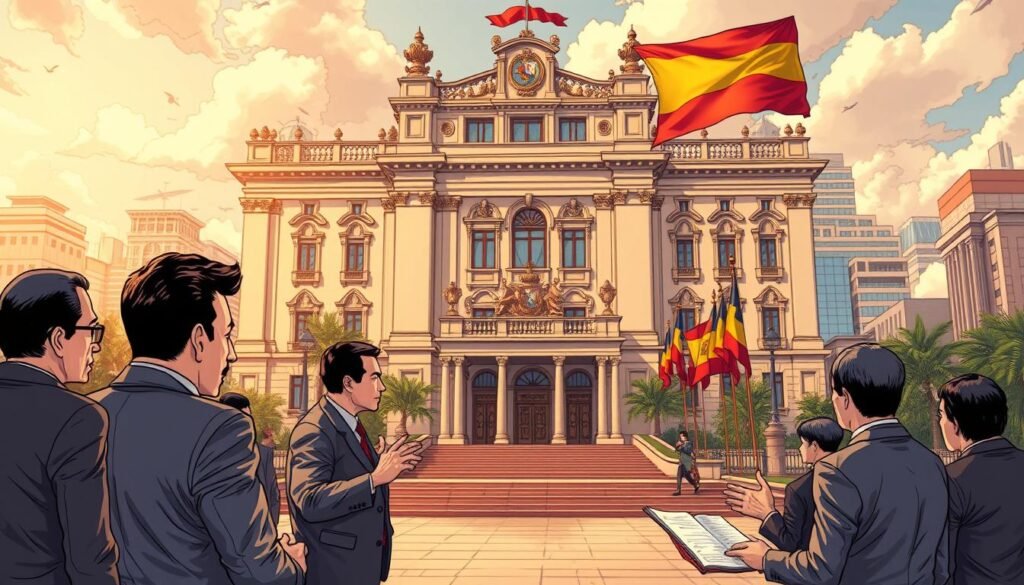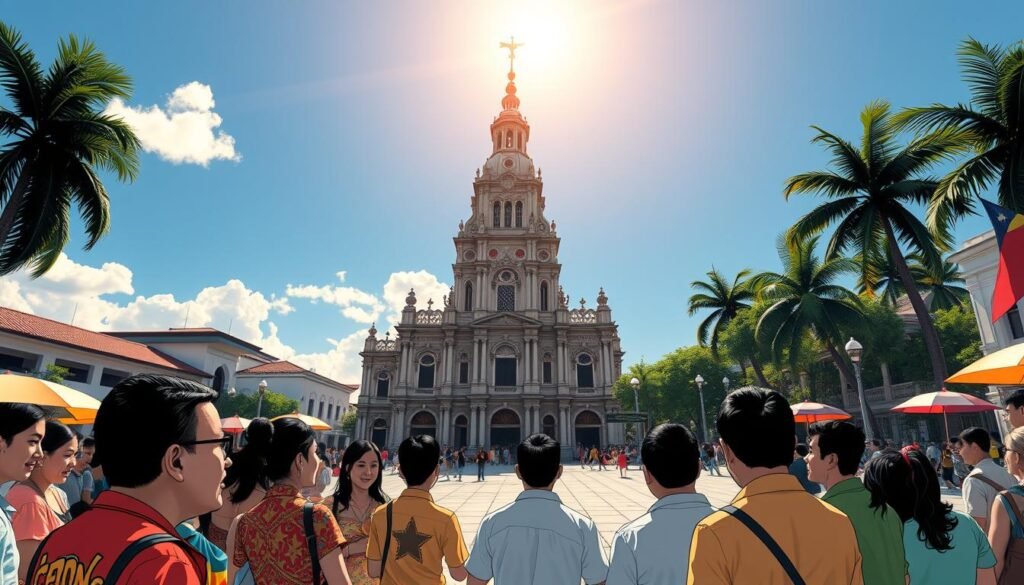Did you know that over 600 million people worldwide speak Spanish? This makes it the second most spoken native language globally, after Mandarin Chinese. Its influence stretches across continents, from the Iberian Peninsula to Latin America and beyond.
Spanish has deep historical roots, evolving from Vulgar Latin and Castilian developments. Today, it serves as an official language in more than 18 countries, playing a crucial role in diplomacy, governance, and cultural heritage. Its widespread use has made it a key player in international organizations like the United Nations.
From colonial administration to modern governmental systems, Spanish has shaped policies and institutions. Countries like Mexico and Spain showcase its enduring impact. The language continues to evolve, adapting to the needs of a globalized world while preserving its rich history.
Key Takeaways
- Spanish is the second most spoken native language globally.
- It is an official language in over 18 countries.
- Spanish plays a vital role in diplomacy and international organizations.
- Its roots trace back to Vulgar Latin and Castilian developments.
- Countries like Mexico and Spain highlight its cultural and governmental influence.
Introduction to Spanish Influence in Governance
From colonial rule to modern administration, Spanish has left a lasting mark. Its influence extends beyond borders, shaping governance systems in countries like Spain, Mexico, and the Philippines. This section explores how historical events and cultural heritage have intertwined with administrative language use.

Defining the Scope of Spanish Impact
The spread of Spanish began with the Reconquista in the Iberian Peninsula. Later, colonization carried the language to Latin America and the Philippines. Today, it remains a cornerstone of governance in many regions.
Historical figures like Antonio de Nebrija played a key role in standardizing the language. His work laid the foundation for its use in legal and educational reforms. This standardization helped integrate Spanish into administrative systems worldwide.
Historical and Cultural Tie-Ins
Spanish evolved from Latin, a process that began centuries ago. Over time, it developed into various dialects, each with unique characteristics. These dialects reflect the cultural diversity of Spanish-speaking regions.
In the Philippines, Spanish was introduced during colonial rule. It became a tool for administration and education. Despite its decline in everyday use, its legacy persists in legal and cultural contexts.
| Region | Impact of Spanish |
|---|---|
| Spain | Originated and standardized the language |
| Latin America | Shaped legal and educational systems |
| Philippines | Influenced governance and cultural heritage |
The integration of Spanish into governance highlights its enduring relevance. From historical roots to modern applications, it continues to shape the world today.
Historical Evolution of the Spanish Language
The journey of Spanish began centuries ago, rooted in the evolution of Vulgar Latin. Over time, it transformed into the modern language we recognize today. This transformation was shaped by historical events, cultural shifts, and influential figures.

From Vulgar Latin to Modern Spanish
Spanish traces its origins to Vulgar Latin, the spoken form of Latin used in the Roman Empire. As the empire declined, regional dialects emerged. These dialects laid the foundation for modern Spanish.
Medieval events, like the Reconquista, played a crucial role in consolidating the language. The Reconquista unified the Iberian Peninsula under Christian rule, fostering linguistic standardization.
Antonio de Nebrija’s work in the late 15th century was pivotal. His grammar and dictionary codified Spanish, making it a tool for administration and education. This standardization helped Spanish spread globally.
Spain’s Colonial Legacy
Spain’s colonial expansion in the 16th century carried the language to new territories. From Latin America to the Philippines, Spanish became a key part of governance and culture.
Colonial administration centers, like Mexico City and Lima, preserved central peninsular norms. These regions retained features of the original language, influencing local dialects.
Today, Spanish is spoken by millions worldwide. Its colonial legacy continues to shape legal systems, literature, and cultural identity in many countries.
| Event | Impact on Spanish |
|---|---|
| Roman Empire | Introduction of Vulgar Latin |
| Reconquista | Consolidation of dialects |
| Nebrija’s Work | Standardization of grammar |
| Colonial Expansion | Global spread of Spanish |
The historical evolution of Spanish highlights its adaptability and enduring influence. From its Latin roots to its global presence, the language continues to shape the world.
Spanish Language in the Philippine Government
The Philippines’ administrative systems were deeply shaped by colonial influences. During the 333 years of Spanish rule, the language became a cornerstone of governance. It was used in legal, educational, and administrative frameworks, leaving a lasting legacy.

Administrative Adoption and Legacy
Colonial rulers introduced Spanish as the official language of governance. It was used in legal codes, government decrees, and educational materials. This integration helped standardize administrative practices across the archipelago.
By the late 19th century, Spanish was widely used in Manila. Around 50% of the city’s population was proficient in the language. This proficiency facilitated smoother governance and communication.
Legal and educational institutions adopted Spanish norms. Schools taught in Spanish, and legal documents were written in the language. This integration ensured that Spanish became deeply embedded in the country’s administrative systems.
Linguistic Legacy in Modern Governance
Even after independence, the linguistic legacy of Spanish persisted. Many legal terms and government documents still reflect Spanish influence. For example, the Malolos Constitution of 1899 was written in Spanish.
Chavacano, a Spanish-based creole, is still spoken by around 689,000 people. This dialect serves as a living reminder of the colonial era’s linguistic impact.
| Aspect | Impact of Spanish |
|---|---|
| Legal Systems | Introduced Spanish legal terms and codes |
| Education | Spanish was the medium of instruction |
| Government Documents | Official decrees and constitutions were written in Spanish |
| Cultural Heritage | Chavacano and Spanish loanwords remain in use |
The cultural impact of Spanish continues to shape the Philippines. From legal systems to everyday language, its legacy is undeniable. This historical integration highlights the enduring influence of colonial governance.
Influence on Colonial and Post-Colonial Administration
The colonial era brought significant changes to administrative systems, with Spanish playing a pivotal role in shaping governance. From legal codes to educational reforms, its influence extended far beyond the Iberian Peninsula.

Role in Educational and Legal Reforms
During colonial rule, Spanish became the medium of instruction in schools and the language of legal documents. This integration helped standardize education and law across regions like Latin America and the Philippines.
For example, the Recopilación de Leyes de los Reynos de las Indias was a comprehensive legal code that shaped colonial governance. It introduced Spanish legal norms to newly colonized territories.
Educational reforms focused on teaching Spanish to local populations. Schools were established to promote literacy and administrative efficiency. This legacy continues in modern institutions, where Spanish loanwords and legal terms remain prevalent.
Post-colonial administrations retained many of these reforms. In the Philippines, the Malolos Constitution of 1899 was written in Spanish, reflecting its enduring influence. Similarly, Latin American countries adapted Spanish legal frameworks to their independent governance systems.
- Spanish standardized education and legal systems during colonial rule.
- Legal codes like the Recopilación de Leyes shaped governance.
- Modern institutions still reflect Spanish linguistic and legal influences.
The adaptation of Spanish in judicial and bureaucratic settings highlights its lasting impact. From colonial times to the present, it has shaped the administrative landscape of many countries.
Linguistic Characteristics Shaping Administration
The linguistic features of Spanish play a critical role in shaping administrative systems worldwide. Its grammar, vocabulary, and regional variations influence how official communication is structured and understood. These elements ensure clarity and precision in governance, making Spanish a vital tool in public administration.
Grammar and Vocabulary in Official Use
Spanish grammar, with its subject-object structure and diacritical marks, ensures clarity in legal and administrative documents. For example, the use of accents helps distinguish between words like sí (yes) and si (if), reducing ambiguity in official texts.
Vocabulary precision is equally important. Terms like ley (law) and decreto (decree) are carefully chosen to convey specific meanings. This precision is crucial in legal frameworks, where even a single word can alter the interpretation of a law.
Pronouns and verb forms also play a key role. The distinction between usted (formal you) and tú (informal you) reflects the level of formality required in official communication. This linguistic nuance ensures respect and professionalism in governance.
Dialects and Regional Variations
Regional dialects add another layer of complexity to administrative language. In Latin America, for instance, the use of vos instead of tú is common in countries like Argentina and Uruguay. These variations reflect cultural diversity but can also pose challenges in standardized governance.
In Spain, the Castilian dialect serves as the standard for official documents. However, regional languages like Catalan and Basque coexist, influencing local administration. This diversity highlights the need for linguistic adaptability in governance.
Standardized forms of Spanish are often used in international organizations to ensure consistency. Yet, regional dialects continue to shape local policies, demonstrating the dynamic nature of the language in administrative contexts.
“Language is the roadmap of a culture. It tells you where its people come from and where they are going.”
For more insights into the historical scripts that influenced modern languages, explore this guide to Baybayin, an ancient Filipino script.
Government Policies and Spanish Cultural Heritage
Government policies play a crucial role in preserving cultural heritage. In many countries, these policies ensure that traditions, arts, and linguistic practices are safeguarded for future generations. Spain, for example, has implemented laws like Law 16/1985 to manage its historical heritage effectively.
Efforts to preserve the Spanish language are a key part of these policies. Programs focus on teaching and promoting the language in schools and public institutions. This ensures that it remains a vital part of national identity and cultural expression.

Cultural heritage programs often include initiatives to promote literature and arts. For instance, Spain’s UNESCO World Heritage Sites, such as the Alhambra and Sagrada Familia, are protected and promoted through state-sponsored campaigns. These efforts highlight the country’s rich history and artistic achievements.
In Latin America, similar programs focus on preserving indigenous languages and traditions alongside Spanish. This dual approach ensures a diverse cultural landscape while honoring the region’s colonial history.
| Country | Cultural Heritage Program |
|---|---|
| Spain | Protection of UNESCO World Heritage Sites |
| Mexico | Promotion of indigenous and Spanish literature |
| Argentina | Language preservation in schools |
These policies not only preserve cultural heritage but also strengthen national identity. By integrating traditions into governance, countries ensure that their history remains alive and relevant in the modern world.
Comparative Perspectives: Spanish vs. Other Colonial Languages
Colonial languages have shaped governance systems across the globe, each leaving a unique mark. Among these, Spanish and Portuguese stand out for their widespread influence. Both originated in the Iberian Peninsula, yet their evolution and application in administration differ significantly.

Spanish, rooted in Latin, became a dominant force in Latin America. Its standardized grammar and vocabulary facilitated clear communication in legal and administrative contexts. Portuguese, on the other hand, spread to Brazil and parts of Africa, adapting to local dialects and cultural nuances.
Impact on Modern Legal Systems
In Latin America, Spanish legal frameworks are deeply embedded in governance. Countries like Mexico and Argentina use Spanish in their constitutions and legal codes. This uniformity ensures consistency across regions, making it easier to enforce laws.
Portuguese, however, showcases more regional variation. In Brazil, legal documents often incorporate local terms and expressions. This adaptability reflects the country’s diverse cultural landscape but can also lead to challenges in standardization.
“Language is not just a tool for communication; it is a reflection of history and identity.”
Case studies from Africa highlight these differences. In Angola, Portuguese serves as the official language, but local dialects influence its use in governance. This dual approach preserves cultural heritage while maintaining administrative efficiency.
- Spanish legal systems emphasize uniformity and clarity.
- Portuguese frameworks adapt to regional dialects and cultural contexts.
- Both languages play a vital role in shaping modern governance.
The comparative analysis of Spanish and Portuguese reveals their unique contributions to administration. While Spanish prioritizes standardization, Portuguese embraces diversity. Together, they illustrate the enduring impact of colonial languages on the world stage.
Spanish in Diplomatic and Foreign Relations
Diplomatic relations often hinge on the ability to communicate effectively across cultures. In this context, the Spanish language has emerged as a powerful tool in international diplomacy. Its widespread use in over 18 countries makes it a key player in global negotiations and treaties.
One notable example is Spain’s role in the United Nations. Since joining in 1955, Spain has actively participated in peacekeeping missions and international forums. The ability to communicate in Spanish has facilitated smoother negotiations, especially in Latin America and the Mediterranean region.

Language skills are crucial in diplomacy. A study by the British Council found that 75% of international organizations consider multilingualism essential for effective communication. Spanish, being the second most spoken native language globally, holds a significant advantage in this regard.
In Latin America, Spanish has been instrumental in shaping foreign policy. For instance, the Treaty of Tordesillas (1494) divided the New World between Spain and Portugal, showcasing early diplomatic negotiation skills. Today, Spanish continues to influence bilateral relations, particularly in cultural and economic cooperation.
- Spanish is a key language in international diplomacy.
- Spain’s participation in the UN highlights its global influence.
- Multilingualism enhances diplomatic negotiations, with Spanish playing a vital role.
- Historical treaties like the Treaty of Tordesillas demonstrate Spanish diplomatic skills.
Comparing Spanish with other languages, its global influence is second only to English. While English dominates in many international settings, Spanish offers a unique advantage in regions like Latin America and parts of Europe. This dual influence makes it a versatile tool in foreign relations.
“Language is not just a tool for communication; it is a reflection of history and identity.”
In conclusion, the Spanish language continues to shape diplomatic and foreign relations worldwide. Its historical roots and modern applications make it an indispensable asset in the ever-evolving landscape of international diplomacy.
Spanish Contributions to Philippine Literature and Art
The Philippines’ literary and artistic heritage has been profoundly shaped by centuries of cultural exchange. From the colonial period to modern times, the influence of Spanish has left a lasting imprint on the nation’s creative expression. This section explores how this legacy has shaped public discourse, art, and national identity.

Literary Influences on Public Discourse
Spanish played a pivotal role in shaping Philippine literary culture. Early works like the Doctrina Christiana, published in 1593, marked the beginning of a rich literary tradition. This book, the first printed in the Philippines, blended religious teachings with local languages, setting the stage for future literary developments.
In the 19th century, writers like Jose Rizal used Spanish to critique societal issues. His novels, Noli Me Tangere and El Filibusterismo, became catalysts for the Propaganda Movement, advocating for reforms under colonial rule. These works not only influenced public discourse but also inspired the Philippine Revolution.
Francisco Baltazar, known as Balagtas, is another key figure. His narrative poem Florante at Laura is celebrated as a masterpiece of traditional Tagalog poetry. Through allegory, it addressed themes of tyranny and freedom, resonating deeply with Filipino readers.
Artistic Expression and Cultural Identity
The influence of Spanish extends beyond literature into the visual arts. The establishment of the Academia de Dibujo in 1821 marked the formalization of fine arts education in the Philippines. Artists like Juan Luna and Felix Resurreccion Hidalgo gained international acclaim, with Luna’s Spoliarium winning a gold medal at the 1884 Madrid Exposition.
These artistic achievements reflect a blend of European techniques and Filipino themes. They not only showcased the talent of Filipino artists but also contributed to the nation’s cultural identity. For more insights into this cultural fusion, explore Hispanofilipina literature.
| Work | Author | Significance |
|---|---|---|
| Doctrina Christiana | Anonymous | First printed book in the Philippines |
| Florante at Laura | Francisco Baltazar | Masterpiece of Tagalog poetry |
| Noli Me Tangere | Jose Rizal | Catalyst for the Propaganda Movement |
| Spoliarium | Juan Luna | Gold medal at the 1884 Madrid Exposition |
The integration of Spanish into Philippine literature and art highlights its enduring impact. From historical texts to modern masterpieces, this cultural exchange continues to shape the nation’s creative landscape.
Role of Spanish Language in Shaping National Identity
Language serves as a cornerstone of national identity, shaping how communities perceive themselves and their history. In many post-colonial settings, the Spanish language has played a pivotal role in unifying diverse populations and preserving cultural heritage. Its integration into governance and education has further solidified its importance in shaping national identity.

Cultural Identity and Administrative Integration
The influence of Spanish extends beyond communication. In countries like the Philippines and Latin America, it has become a symbol of cultural unity. For example, in the Philippines, Spanish was used in legal and educational systems during colonial rule, leaving a lasting legacy in governance and cultural expression.
In Latin America, Spanish has been instrumental in fostering a shared identity among diverse populations. Countries like Mexico and Argentina use Spanish in their constitutions, ensuring consistency in legal frameworks. This uniformity has helped strengthen national unity and cultural pride.
“Language is not just a tool for communication; it is a reflection of history and identity.”
Government policies have also played a crucial role in preserving the Spanish language. Programs focused on teaching and promoting Spanish in schools and public institutions ensure its continued relevance. These efforts highlight the language’s role in maintaining cultural heritage and national identity.
- Spanish has unified diverse populations in post-colonial settings.
- Its integration into governance and education has strengthened national identity.
- Government policies ensure the preservation of Spanish cultural heritage.
For more insights into the relationship between language and national identity, explore this detailed analysis.
Legacy of Key Figures and Historical Milestones
The evolution of Spanish linguistics owes much to the contributions of key historical figures and pivotal milestones. From the standardization of grammar to the spread of the language across continents, these individuals and events have shaped its development.
Influential Leaders and Educators
Antonio de Nebrija stands as a towering figure in the history of Spanish. His 1492 grammar book, Gramática de la lengua castellana, was the first to codify the rules of a modern European language. This work not only standardized Spanish but also laid the foundation for its use in education and administration.
Another notable figure is Andrés Bello, a Venezuelan scholar who contributed to the preservation of Spanish in Latin America. His grammar book, Gramática de la lengua castellana destinada al uso de los americanos, addressed regional variations and ensured the language’s continuity in newly independent nations.
Pioneering Works in Spanish Linguistics
The 16th century marked a turning point with the publication of Nebrija’s dictionary, Vocabulario español-latino. This work expanded the language’s vocabulary and influenced its use in legal and literary contexts. Similarly, the Recopilación de Leyes de los Reynos de las Indias standardized legal terminology across Spanish colonies.
In the 19th century, the Real Academia Española (RAE) was established to regulate and promote the language. Its Diccionario de la lengua española remains a cornerstone of linguistic authority, ensuring consistency in spelling, grammar, and usage.
“Language is the archive of history, the guardian of culture, and the vehicle of thought.”
Key milestones in the evolution of Spanish include the Treaty of Córdoba in 1821, which marked Mexico’s independence and the language’s continued role in governance. For more on these transformative events, explore key events in Spanish history.
- Antonio de Nebrija’s grammar book standardized Spanish in 1492.
- Andrés Bello’s work preserved the language in Latin America.
- The RAE’s dictionary ensures linguistic consistency.
- The Treaty of Córdoba highlighted Spanish’s role in governance.
These contributions and milestones underscore the enduring legacy of Spanish linguistics. From its roots in Latin to its global presence, the language continues to evolve while honoring its rich history.
Integration of Spanish Language in Modern Media and Technology
The digital age has transformed how we consume and interact with media, with Spanish playing a central role in this evolution. From streaming platforms to social media, the language has become a dominant force in global communication. This shift has not only expanded its reach but also reshaped how it is used in technology and public policy.
Traditional media formats like television and radio have given way to online platforms. Streaming services like Netflix and Spotify now offer extensive Spanish content, catering to millions of users worldwide. Social media platforms such as Instagram and TikTok have also become hubs for Spanish-speaking creators, fostering a vibrant digital community.
Mobile apps and educational programs are further enhancing Spanish fluency. Apps like Duolingo and Babbel provide interactive lessons, making language learning accessible to everyone. These tools are not just for individuals but also support government initiatives to promote bilingualism and cultural exchange.
“Technology has made it easier than ever to connect with diverse audiences, and Spanish is at the forefront of this global conversation.”
Innovations in technology are also influencing government communication. For example, Adhere+ has integrated Spanish into its telehealth platform, improving accessibility for Spanish-speaking patients. This trend highlights the growing importance of language in public policy and healthcare.
| Platform | Role in Spanish Integration |
|---|---|
| Netflix | Offers a wide range of Spanish-language shows and movies |
| Spotify | Features Spanish music and podcasts for global audiences |
| Duolingo | Provides interactive Spanish lessons for learners |
| Adhere+ | Enhances healthcare accessibility with Spanish support |
These advancements underscore the adaptability of Spanish in the digital era. As technology continues to evolve, the language will remain a vital tool for communication, education, and cultural preservation.
Education and the Preservation of Spanish Heritage
Universities are stepping up efforts to maintain cultural identity through language education. Academic programs dedicated to Spanish studies are playing a vital role in preserving linguistic heritage. These initiatives ensure that traditions and dialects are passed down to future generations.
Academic Programs and Language Learning Initiatives
Institutions like the University of Texas Permian Basin offer specialized degrees and certificates in Spanish. These programs focus on fluency, cultural understanding, and historical context. Students gain a deep appreciation for the language’s role in shaping societies.
Online degrees and certificates are making language learning more accessible. Platforms provide interactive courses that cater to diverse learning styles. This flexibility empowers individuals to enhance their fluency while balancing other commitments.
Formal education offers numerous benefits for cultural preservation. It fosters a sense of identity and pride among heritage speakers. Courses often include literature, history, and community outreach, creating a well-rounded learning experience.
| Program | Focus Area |
|---|---|
| Spanish Heritage Program | Cultural identity and fluency |
| Online Certificates | Accessible language learning |
| Community Outreach | Engaging local heritage speakers |
Community outreach programs are another key component. They connect learners with local heritage speakers, fostering real-world language use. This approach ensures that the language remains alive and relevant in everyday contexts.
“Language is the roadmap of a culture. It tells you where its people come from and where they are going.”
For more insights into the challenges and opportunities in heritage language education, explore this detailed study.
Economic and Social Impact of Spanish Language Use
The global economy thrives on communication, and Spanish has become a key player in this dynamic. With over 470 million native speakers, it is the second most spoken native language worldwide. This widespread use creates significant economic and social advantages for those who master it.
Job Opportunities and International Trade
Bilingual skills, especially in Spanish, are highly valued in today’s job market. In the United States, professionals fluent in Spanish earn nearly 10% more than their monolingual counterparts. This advantage extends to industries like healthcare, education, and international trade.
In Latin America, Spanish is the backbone of business communication. Companies looking to expand into these markets often seek employees who can bridge cultural and linguistic gaps. This demand has led to a surge in job opportunities for Spanish speakers.
Global trade also benefits from Spanish proficiency. Sharing a language increases bilateral flows of foreign direct investment (FDI) seven-fold. This makes Spanish a valuable asset for businesses aiming to strengthen international partnerships.
| Region | Economic Impact of Spanish |
|---|---|
| United States | 10% higher earnings for bilingual professionals |
| Latin America | Increased FDI and trade opportunities |
| Europe | Second most taught language, boosting job prospects |
Success stories abound. For example, a U.S. company expanded its operations into Mexico by hiring Spanish-speaking staff. This move not only increased revenue but also strengthened cross-border relationships.
For more insights into the economic value of Spanish, explore this detailed analysis.
“Language is the key to unlocking global opportunities, and Spanish is leading the way.”
In conclusion, the ability to speak Spanish opens doors to better jobs, higher earnings, and stronger international ties. As the world becomes more interconnected, this skill will continue to shape economic and social landscapes.
Conclusion
The Spanish language has left an indelible mark on governance, culture, and education worldwide. Its historical roots trace back to Latin, evolving through centuries to become a cornerstone of modern administrative systems. From legal frameworks to diplomatic relations, its influence remains profound.
Cultural and economic benefits of fluency are undeniable. Countries like Spain and those in Latin America showcase how language shapes national identity and fosters unity. The integration of Spanish into policy and education ensures its legacy endures.
As we reflect on its journey, it’s clear that the language continues to bridge cultures and drive progress. For a deeper dive into its evolution, explore the history of Spanish. Its story is far from over, offering endless opportunities for exploration and connection.
FAQ
How did the Spanish language influence governance in the Philippines?
The Spanish language played a key role in the Philippines’ administration during colonial times. It was used in legal documents, education, and official communication, leaving a lasting legacy in the country’s governance structure.
What is the historical evolution of the Spanish language?
The language evolved from Vulgar Latin, influenced by regional dialects and cultural shifts. Spain’s colonial expansion further shaped its development, spreading it across Latin America and parts of Asia.
How does Spanish compare to other colonial languages in governance?
Unlike other colonial languages, Spanish deeply integrated into local legal and educational systems. Its influence remains visible in modern legal frameworks and administrative practices in former colonies.
What role does Spanish play in modern diplomacy?
Spanish is a major diplomatic language, facilitating communication in international relations. It is widely used in global organizations and bilateral agreements, especially in Latin America and Europe.
How has Spanish shaped Philippine literature and art?
Spanish introduced new literary forms and artistic styles to the Philippines. This influence is evident in classical works and public discourse, blending local and European traditions.
What efforts are made to preserve Spanish heritage in education?
Academic programs and language initiatives aim to keep Spanish alive. Schools and universities offer courses to teach the language and its cultural significance to new generations.
What economic benefits come from knowing Spanish?
Proficiency in Spanish opens job opportunities in international trade, tourism, and diplomacy. It also strengthens ties with Spanish-speaking countries, boosting economic collaboration.
How did Spanish contribute to shaping national identity in the Philippines?
The language became a part of the Philippines’ cultural fabric, blending with local traditions. It played a role in unifying diverse regions under a shared administrative and cultural framework.
Who were key figures in promoting Spanish in the Philippines?
Influential leaders and educators, such as José Rizal, championed the use of Spanish. Their works and advocacy helped integrate the language into the country’s intellectual and administrative life.
How is Spanish integrated into modern media and technology?
Spanish is widely used in digital content, social media, and entertainment. Its presence in technology platforms ensures its relevance in today’s globalized world.
Source Links
- Spanish in the world
- Institutions of Spain
- Philippines – Spanish Colonization, Culture, Trade | Britannica
- No title found
- Colonial Government in the Spanish Empire
- Spanish language | History, Speakers, & Dialects | Britannica
- The History of the Spanish Language | Lingvist
- History of the Spanish language
- Spanish language in the Philippines
- Philippine Literature in Spanish – National Commission for Culture and the Arts
- A History of the Philippines’ official languages
- Postcolonialism
- Colonial Shadows: How Language and Script Dominance Echo Past Conquests
- Language and colonialism. Applied linguistics in the context of creole communities.
- Linguistic diversity and equality within the public administration: Issues and challenges
- Spain – Herein System – www.coe.int
- Preserving Spain’s Cultural Heritage: Challenges and Solutions – Center for Art Law
- Languages: “Castilian” Spanish, “Mexican” Spanish, and Other Spanishes
- Lozano discusses ‘An American Language: The History of Spanish in the United States’
- Morphosyntactic Variation in Spanish (Chapter 11) – English and Spanish
- Foreign relations of Spain
- Spain International Relations: Diplomacy & Alliances
- Spanish Diplomacy: Tactics, Evolution | StudySmarter
- Philippine Literature in the Spanish Colonial Period – National Commission for Culture and the Arts
- The Spanish Colonial Tradition in Philippine Visual Arts – National Commission for Culture and the Arts
- Spanish influence on Filipino culture
- The Impact of Spanish Language in Shaping Cultural Identity
- Spanish – Core Concepts
- Hispanic History Milestones: Timeline
- The Significance of Spanish Colonial Missions in our National Story and our Common Heritage with Spain, Mexico and Latin America (U.S. National Park Service)
- Integrating Artificial Intelligence and Big Data in Spanish Journalism Education: A Curricular Analysis
- Latinos’ Views of and Experiences With the Spanish Language
- Teaching Spanish as a heritage language for the first time: Ten suggestions
- Spanish as a Heritage Language | College of Liberal and Fine Arts
- Spanish Language in Africa. Its Economic Role South of the Sahara
- The Economic Returns of Foreign Language Learning
- 1-Assessing the Economic Value of the Spanish Language. – IMAC Spanish Language Programs – Guadalajara, Jalisco
- Frontiers | The Spanish Language as a Cultural and Touristic Resource for the Chinese Market to Develop Quality Education
- 1+2 languages policy: findings from the 2023 survey of local authorities

